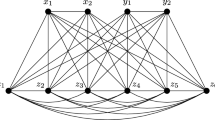Abstract
A set ofk spanning trees of a graphG is calledmaximally distant if their union contains the maximum number of edges ofG. We present a necessary and sufficient condition for a set of spanning trees to be maximally distant. We also give an efficient algorithm which actually findsk maximally distant spanning trees in a given graph.
Zusammenfassung
Eine Menge vonk Gerüsten eines GraphenG heißtmaximal entfernt, falls ihre Vereinigung eine maximale Anzahl von Kanten des Graphen enthält. Es wird eine notwendige und hinreichende Bedingung angegeben, die gewährleistet, daß eine Menge von Gerüsten maximal entfernt ist. Dann wird ein effizienter Algorithmus beschrieben, der in einem gegebenen Graphenk maximal entfernte Gerüste findet.
Similar content being viewed by others
Explore related subjects
Discover the latest articles, news and stories from top researchers in related subjects.References
Berge, C.: Graphs and Hypergraphs. New York: American Elsevier 1973.
Chase, S. M.: An implemented graph algorithm for winning Shannon switching games. Comm. ACM15, 253–256 (1972).
Edmonds, J.: Minimum partition of a matroid into independent subsets. J. Res. NBS69B, 67–72 (1965).
Kameda, T.: An algorithm for finding maximally distant spanning trees. Seminar Report, I. R. I. A., Roquencourt, France, 1974.
Kameda, T., Toida, S.: Efficient algorithms for determining an extremal tree of a graph. Proc. 14th Ann. IEEE Symp. Switch. Automata Theory, 12–15 (1973).
Kishi, G., Kajitani, Y.: On maximally distant trees and principal partition of a linear graph. IEEE Trans. CT-16, 323–330 (1969).
Lehman, A.: A solution to the Shannon switching game. SIAM J. Appl. Math.12, 684–725 (1964).
Nash-Williams, C. St. J. A.: Edge-disjoint spanning trees of finite graphs. J. London Math. Soc.36, 445–450 (1961).
Nash-Williams, C. St. J. A.: Decomposition of finite graphs into forests. J. London Math. Soc.39, 12 (1964).
Ohtsuki, T., Ishizaki, Y., Watanabe, H.: Topological degrees of freedom and mixed analysis of electrical networks. IEEE Trans. CT-17, 491–499 (1970).
Tarjan, R. E.: Depth-first search and linear graph algorithms. SIAM J. Computing1, 146–159 (1972).
Tutte, W. T.: On the problem of decomposing a graph inton connected factors. J. London Math. Soc.3, 221–230 (1961).
Author information
Authors and Affiliations
Additional information
This work was supported in part by the National Research Council of Canada under Grant No. A4135 and was carried out while the author was Visiting Professor at the Institut für Angewandte Mathematik, Universität Frankfurt, Germany, during 1973–1974. The original version of this work has appeared as an internal report [4].
Rights and permissions
About this article
Cite this article
Kameda, T. On maximally distant spanning trees of a graph. Computing 17, 115–119 (1976). https://doi.org/10.1007/BF02276756
Received:
Issue Date:
DOI: https://doi.org/10.1007/BF02276756




